Pricing Guides & Dictionary of Makers Marks for Antiques & Collectibles

A few examples of appraisal values for
DUKE OF MARLBOROUGH
Search our price guide for your own treasures
-
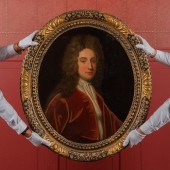 OIL PORTRAIT OF JOHN CHURCHILL,
OIL PORTRAIT OF JOHN CHURCHILL, DUKE OF MARLBOROUGHA 19th century oil after Enoch Seeman's 1720 portrait of John Churchill, the 1st Duke of Marlborough, in scarlet military regalia. Measures 30" x 25 1/4", in a frame that measures 38 1/4" x 33 1/2". Provenance: The Shirley Bush Helzberg and Webster House collections. Condition Small area of residue above and to the left of the head, and some abrasion lines near the left sight edge. Under blacklight inspection, there is a thin layer of overpainting on the coat's contours, which dulls the original more brightly painted contours. No other in-painting or over-painting.
OIL PORTRAIT OF JOHN CHURCHILL,
OIL PORTRAIT OF JOHN CHURCHILL, DUKE OF MARLBOROUGHA 19th century oil after Enoch Seeman's 1720 portrait of John Churchill, the 1st Duke of Marlborough, in scarlet military regalia. Measures 30" x 25 1/4", in a frame that measures 38 1/4" x 33 1/2". Provenance: The Shirley Bush Helzberg and Webster House collections. Condition Small area of residue above and to the left of the head, and some abrasion lines near the left sight edge. Under blacklight inspection, there is a thin layer of overpainting on the coat's contours, which dulls the original more brightly painted contours. No other in-painting or over-painting. -
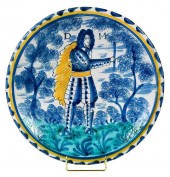 ENGLISH DELFTWARE 'DUKE OF
ENGLISH DELFTWARE 'DUKE OF MARLBOROUGH' CHARGERattributed to London or Bristol, circa 1704-11, painted full length figure of John Churchill, the first Duke of Marlborough (1650-1722), wearing armor and yellow cloak, holding a baton, flanked by initials "DM", blue sponged trees, standing on green grassy clumps, blue dash rim with inner yellow border, 2-1/4 x 13-3/8 in. Provenance: Jonathan Horne, London; Property from the Collection of Dudley and Constance Godfrey Condition: faint glaze hairlines/crazing, small chips, glaze fritting, scratches
ENGLISH DELFTWARE 'DUKE OF
ENGLISH DELFTWARE 'DUKE OF MARLBOROUGH' CHARGERattributed to London or Bristol, circa 1704-11, painted full length figure of John Churchill, the first Duke of Marlborough (1650-1722), wearing armor and yellow cloak, holding a baton, flanked by initials "DM", blue sponged trees, standing on green grassy clumps, blue dash rim with inner yellow border, 2-1/4 x 13-3/8 in. Provenance: Jonathan Horne, London; Property from the Collection of Dudley and Constance Godfrey Condition: faint glaze hairlines/crazing, small chips, glaze fritting, scratches -
 THE MILITARY HISTORY OF HIS
THE MILITARY HISTORY OF HIS SERENE HIGHNESS PRINCE EUGE...The Military HIstory of His Serene Highness Prince Eugene of Savoy and also Duke of Marlborough Late Prince of Roman Empire and Price of Nassau Triesland, printed by R. Walker, London, MDCCXXXV. Condition: All lots are sold "AS IS" The condition of lots can vary widely and are unlikely to be in a perfect condition. *No credit card payments will be accepted for silver, gold, or jewelry from buyers that have not purchased from our gallery in the past.
THE MILITARY HISTORY OF HIS
THE MILITARY HISTORY OF HIS SERENE HIGHNESS PRINCE EUGE...The Military HIstory of His Serene Highness Prince Eugene of Savoy and also Duke of Marlborough Late Prince of Roman Empire and Price of Nassau Triesland, printed by R. Walker, London, MDCCXXXV. Condition: All lots are sold "AS IS" The condition of lots can vary widely and are unlikely to be in a perfect condition. *No credit card payments will be accepted for silver, gold, or jewelry from buyers that have not purchased from our gallery in the past. -
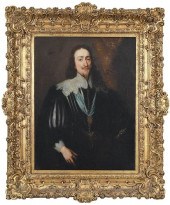 STUDIO OF ANTHONY VAN DYCK(Flemish,
STUDIO OF ANTHONY VAN DYCK(Flemish, 1599-1641) Portrait of King Charles I (1630-1685), wearing the Blue Garter Ribbon, unsigned, an early copy, possibly one of the pendant pairs that were early copies of the prime which is not located (IV.A8)(1632), oil on canvas, 45 x 33-1/8 in. (114.3 x 83.82 cm.); fine gilt wood frame, 62-1/2 x 52-1/2 in. Note: The original portrait was painted as a pendant to the portrait of Queen Henrietta Maria. Oliver Millar states, "A three quarter length of the king was produced by Van Dyck as a pendant to the portrait of the Queen (IV.115) now in the Loyd Collection. It is recorded with the pendant in early references cited under IV.115 and is probably the portrait of the queen in David Teniers of the Archduke's picture gallery, also cited under IV.115. It was in the 8th Duke of Marlborough's sale, Christie's, London, 31 July 1886 (233); see also Blenheim 1862, part I, pg.25. The whereabouts of the portrait is not apparently known, but the composition is recorded in the copy in the pair of copies formerly in a private collection, Scotland (illus.; canvas: 125.7 x 101.6 cm)." This portrait resembles the work of Remee van Leemput (Flemish, 1607-1675) who was an early copyist and associate of Van Dyck. The RKD states there is not enough work on which to judge this painting as that of Leemput. They have stated that it is a worthy copy most importantly in the sensitivity of the artist in the face of the portrait which seems better than the known Scottish copy. The clothing, however, seems less careful than the Scottish copy (see correspondence which accompanies the lot). This portrait will be included in the RKD-Netherlands Institute for Art History database. References: https://www.sammlung.pinakothek.de/de/artwork/02LAQl7Lyk/david-teniers-d-j/ansicht-der-galerie-des-erzherzogs-leopold-in-bruessel-ii) The pendant of Queen Henrietta Maria: https://upload.wikimedia.org/wikipedia/commons/1/1f/Anthony_van_Dyck_%281599-1641%29_-_Queen_Henrietta_Maria_%281609-69%29_-_RCIN_404430_-_Royal_Collection.jpg Literature: O. Millar in S. Barnes et al., Van Dyck, a Complete Catalogue of the Paintings, New Haven and London , 2004, p. 631, no. IV.A8 and pp. 520-521, no. IV115. John Smith, A Catalogue Raisonn‚ of the Works of the Most Eminent Dutch, Flemish and French Painters: Anthony van Dyck, and David Teniers, pg. 78, no. 256 Provenance: New York Estate, purchased Circa 1950s Condition: 19th century paste and linen lining, restretched on 19th century stretcher, tacking edge on original course linen trimmed, craquelure, five patches verso, retouch, crackle, some spots of overcleaning, two periods of retouch; frame resurfaced, reduced
STUDIO OF ANTHONY VAN DYCK(Flemish,
STUDIO OF ANTHONY VAN DYCK(Flemish, 1599-1641) Portrait of King Charles I (1630-1685), wearing the Blue Garter Ribbon, unsigned, an early copy, possibly one of the pendant pairs that were early copies of the prime which is not located (IV.A8)(1632), oil on canvas, 45 x 33-1/8 in. (114.3 x 83.82 cm.); fine gilt wood frame, 62-1/2 x 52-1/2 in. Note: The original portrait was painted as a pendant to the portrait of Queen Henrietta Maria. Oliver Millar states, "A three quarter length of the king was produced by Van Dyck as a pendant to the portrait of the Queen (IV.115) now in the Loyd Collection. It is recorded with the pendant in early references cited under IV.115 and is probably the portrait of the queen in David Teniers of the Archduke's picture gallery, also cited under IV.115. It was in the 8th Duke of Marlborough's sale, Christie's, London, 31 July 1886 (233); see also Blenheim 1862, part I, pg.25. The whereabouts of the portrait is not apparently known, but the composition is recorded in the copy in the pair of copies formerly in a private collection, Scotland (illus.; canvas: 125.7 x 101.6 cm)." This portrait resembles the work of Remee van Leemput (Flemish, 1607-1675) who was an early copyist and associate of Van Dyck. The RKD states there is not enough work on which to judge this painting as that of Leemput. They have stated that it is a worthy copy most importantly in the sensitivity of the artist in the face of the portrait which seems better than the known Scottish copy. The clothing, however, seems less careful than the Scottish copy (see correspondence which accompanies the lot). This portrait will be included in the RKD-Netherlands Institute for Art History database. References: https://www.sammlung.pinakothek.de/de/artwork/02LAQl7Lyk/david-teniers-d-j/ansicht-der-galerie-des-erzherzogs-leopold-in-bruessel-ii) The pendant of Queen Henrietta Maria: https://upload.wikimedia.org/wikipedia/commons/1/1f/Anthony_van_Dyck_%281599-1641%29_-_Queen_Henrietta_Maria_%281609-69%29_-_RCIN_404430_-_Royal_Collection.jpg Literature: O. Millar in S. Barnes et al., Van Dyck, a Complete Catalogue of the Paintings, New Haven and London , 2004, p. 631, no. IV.A8 and pp. 520-521, no. IV115. John Smith, A Catalogue Raisonn‚ of the Works of the Most Eminent Dutch, Flemish and French Painters: Anthony van Dyck, and David Teniers, pg. 78, no. 256 Provenance: New York Estate, purchased Circa 1950s Condition: 19th century paste and linen lining, restretched on 19th century stretcher, tacking edge on original course linen trimmed, craquelure, five patches verso, retouch, crackle, some spots of overcleaning, two periods of retouch; frame resurfaced, reduced -
 FOUR TITLES ON GEMS AND JEWELRY
FOUR TITLES ON GEMS AND JEWELRY Notably including GEMMARUM ANTIQUARUM DELECTUS, Duke of Marlborough's Collection (London: Murray, 1845) Volume II only, folio, half morocco, marbled boards, matching end papers; and Ghes MODERN JEWELRY (NY: Crown 1963).
FOUR TITLES ON GEMS AND JEWELRY
FOUR TITLES ON GEMS AND JEWELRY Notably including GEMMARUM ANTIQUARUM DELECTUS, Duke of Marlborough's Collection (London: Murray, 1845) Volume II only, folio, half morocco, marbled boards, matching end papers; and Ghes MODERN JEWELRY (NY: Crown 1963). -
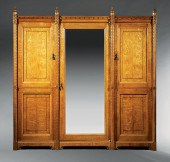 ENGLISH AESTHETIC MOVEMENT CARVED
ENGLISH AESTHETIC MOVEMENT CARVED ASH WARDROBEEnglish Aesthetic Movement Carved Ash Wardrobe , late 19th c. and later, attr. to Lamb of Manchester, dentil-molded cornice surmounted by finials, mirrored door flanked by paneled doors, shaped base, later interior , h. 87 1/2 in., w. 90 1/2 in., d. 12 in. Provenance: By repute, originally made for the Duke of Marlborough
ENGLISH AESTHETIC MOVEMENT CARVED
ENGLISH AESTHETIC MOVEMENT CARVED ASH WARDROBEEnglish Aesthetic Movement Carved Ash Wardrobe , late 19th c. and later, attr. to Lamb of Manchester, dentil-molded cornice surmounted by finials, mirrored door flanked by paneled doors, shaped base, later interior , h. 87 1/2 in., w. 90 1/2 in., d. 12 in. Provenance: By repute, originally made for the Duke of Marlborough -
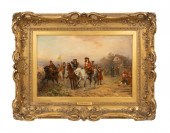 ROBERT HILLINGFORD, MARLBOROUGH
ROBERT HILLINGFORD, MARLBOROUGH AT BLENHEIM, OIL Robert Alexander Hillingford (British 1828 - 1904), "Marlborough And His Ally Prince Eugene Before Blenheim", undated, oil on canvas, historical military genre scene depicting the 1st Duke of Marlborough surrounded by multiple figures on horseback, signed lower right, in giltwood and gesso/composition frame. Provenance: : From the Estate of M. David Merritt, Atlanta, Georgia. Approximate measurements: Canvas h. 17", w. 26"; Overall h. 29", w. 38", d. 4. 25".
ROBERT HILLINGFORD, MARLBOROUGH
ROBERT HILLINGFORD, MARLBOROUGH AT BLENHEIM, OIL Robert Alexander Hillingford (British 1828 - 1904), "Marlborough And His Ally Prince Eugene Before Blenheim", undated, oil on canvas, historical military genre scene depicting the 1st Duke of Marlborough surrounded by multiple figures on horseback, signed lower right, in giltwood and gesso/composition frame. Provenance: : From the Estate of M. David Merritt, Atlanta, Georgia. Approximate measurements: Canvas h. 17", w. 26"; Overall h. 29", w. 38", d. 4. 25". -
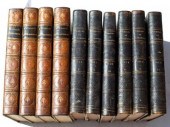 Walpole (H) Private Correspondence,
Walpole (H) Private Correspondence, 4 vols., Rodwell 1820 and Coxe (W) Memoires of John, Duke of Marlborough, 6 vols., Longman 1820, 8vo., cont. half calf
Walpole (H) Private Correspondence,
Walpole (H) Private Correspondence, 4 vols., Rodwell 1820 and Coxe (W) Memoires of John, Duke of Marlborough, 6 vols., Longman 1820, 8vo., cont. half calf -
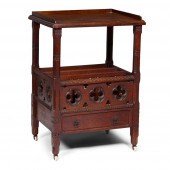 HOLLAND & SON GOTHIC REVIVAL
HOLLAND & SON GOTHIC REVIVAL CANTERBURY TABLE, CIRCA 1870 oak, with brass 'M' handles65cm wide, 91cm high, 48cm deepLiterature:Cooper, Jeremy Victorian and Edwardian Furniture and Interiors: From the Gothic Revival to Art Nouveau, Hong Kong 1998, pl. 120Note: This table is from a celebrated suite of furniture made for John Winston Spencer-Churchill, 7th Duke of Marlborough, circa 1880. Holland & Sons adapted designs they had commissioned from Pugin and the distinctive handles cast with the letter 'M' are distinctive to this commission.
HOLLAND & SON GOTHIC REVIVAL
HOLLAND & SON GOTHIC REVIVAL CANTERBURY TABLE, CIRCA 1870 oak, with brass 'M' handles65cm wide, 91cm high, 48cm deepLiterature:Cooper, Jeremy Victorian and Edwardian Furniture and Interiors: From the Gothic Revival to Art Nouveau, Hong Kong 1998, pl. 120Note: This table is from a celebrated suite of furniture made for John Winston Spencer-Churchill, 7th Duke of Marlborough, circa 1880. Holland & Sons adapted designs they had commissioned from Pugin and the distinctive handles cast with the letter 'M' are distinctive to this commission. -
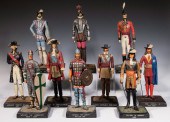 (10) ENGLISH HISTORIC FIGURES BY
(10) ENGLISH HISTORIC FIGURES BY I.H. ARTHUR Hand Crafted Standing Figurines, in painted wood and papier mache, 20th c., each identified on the front of a black painted base, most signed "Made in England by I.H. Arthur" on base, including: Alfred the Great, 10 1/2" high; William the Conqueror, also dated 1969, 10 1/2" high; Duke of Wellington, 12 3/4" high; Sir Walter Raleigh, 11 3/4" high; King Charles I, 10 1/2" high, Viscount Horatio Nelson, 11 1/2" high; William of Orange (later, King William III), 10 1/2" high; Duke of Marlborough, 11 3/4" high; Oliver Cromwell, 10 3/4" high; and Sir Francis Drake, 12 1/2" high. Paint losses.
(10) ENGLISH HISTORIC FIGURES BY
(10) ENGLISH HISTORIC FIGURES BY I.H. ARTHUR Hand Crafted Standing Figurines, in painted wood and papier mache, 20th c., each identified on the front of a black painted base, most signed "Made in England by I.H. Arthur" on base, including: Alfred the Great, 10 1/2" high; William the Conqueror, also dated 1969, 10 1/2" high; Duke of Wellington, 12 3/4" high; Sir Walter Raleigh, 11 3/4" high; King Charles I, 10 1/2" high, Viscount Horatio Nelson, 11 1/2" high; William of Orange (later, King William III), 10 1/2" high; Duke of Marlborough, 11 3/4" high; Oliver Cromwell, 10 3/4" high; and Sir Francis Drake, 12 1/2" high. Paint losses. -
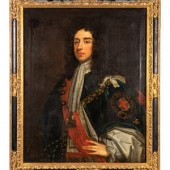 British or French School, 18th
British or French School, 18th Century Portrait of John Churchill, 1st Duke of Marlborough, in the Robes of the Order of the Garter oil on canvas 38 x 30 1/8 inches.
British or French School, 18th
British or French School, 18th Century Portrait of John Churchill, 1st Duke of Marlborough, in the Robes of the Order of the Garter oil on canvas 38 x 30 1/8 inches. -
 Northern European Cream-Painted
Northern European Cream-Painted Beechwood Side Table, first quarter 19th century, in the neoclassical taste, the rounded rectangular top above a frieze fitted with two small drawers, raised on tapering square legs ending in brass caps and casters, stamped on the under side "Lord Blandford" in two locations, h. 30", w. 38-3/4", d. 27-1/2". "Lord Blandford" is the informal style of the Marquess of Blandford, a courtesy title of the Duke of Marlborough in the British peerage and used by the Duke's eldest son and heir. Both titles were created by Queen Anne in 1702 for John Churchill (1650-1722), soldier, statesman and patriarch of the Churchill family, in recognition of his victory over the French in the Spanish Netherlands during the War for the Spanish Succession. A more precious gift, perhaps, was Blenheim Palace, Woodstock, Oxfordshire, the only non-Episcopal house in England to hold the title "palace". Designed by architect Sir John Vanbrugh and built between 1705-1722, it is one of England's largest and grandest homes, with grounds including a park and gardens covering 2,000 acres. It remains today the seat of the Duchy and Marquessate, having housed such illustrious residents as George Spencer (1739-1817), 4th Duke and intimate of George III, George Spencer-Churchill (1766-1840), 5th Duke, antiquarian, bibliophile and roue, and John Spencer-Churchill (1822-1883), 8th Duke and grandfather of Prime Minister Sir Winston Churchill. The palace was largely restored and revived by the 9th Duke, Charles Spencer-Churchill (1871-1934) with the dowry of his American wife, heiress Consuelo Vanderbilt (1877-1964). The palace is today a public trust; the house and grounds are open to the public and a popular location setting for motion pictures, among them Barry Lyndon (1975), Orlando (1992), Kenneth Branagh's Hamlet (1996) and Harry Potter and the Order of the Phoenix (2007).
Northern European Cream-Painted
Northern European Cream-Painted Beechwood Side Table, first quarter 19th century, in the neoclassical taste, the rounded rectangular top above a frieze fitted with two small drawers, raised on tapering square legs ending in brass caps and casters, stamped on the under side "Lord Blandford" in two locations, h. 30", w. 38-3/4", d. 27-1/2". "Lord Blandford" is the informal style of the Marquess of Blandford, a courtesy title of the Duke of Marlborough in the British peerage and used by the Duke's eldest son and heir. Both titles were created by Queen Anne in 1702 for John Churchill (1650-1722), soldier, statesman and patriarch of the Churchill family, in recognition of his victory over the French in the Spanish Netherlands during the War for the Spanish Succession. A more precious gift, perhaps, was Blenheim Palace, Woodstock, Oxfordshire, the only non-Episcopal house in England to hold the title "palace". Designed by architect Sir John Vanbrugh and built between 1705-1722, it is one of England's largest and grandest homes, with grounds including a park and gardens covering 2,000 acres. It remains today the seat of the Duchy and Marquessate, having housed such illustrious residents as George Spencer (1739-1817), 4th Duke and intimate of George III, George Spencer-Churchill (1766-1840), 5th Duke, antiquarian, bibliophile and roue, and John Spencer-Churchill (1822-1883), 8th Duke and grandfather of Prime Minister Sir Winston Churchill. The palace was largely restored and revived by the 9th Duke, Charles Spencer-Churchill (1871-1934) with the dowry of his American wife, heiress Consuelo Vanderbilt (1877-1964). The palace is today a public trust; the house and grounds are open to the public and a popular location setting for motion pictures, among them Barry Lyndon (1975), Orlando (1992), Kenneth Branagh's Hamlet (1996) and Harry Potter and the Order of the Phoenix (2007). -
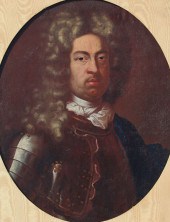 EARLY PORTRAIT OF THE FIRST DUKE OF
EARLY PORTRAIT OF THE FIRST DUKE OF MARLBOROUGH?: Oil/Canvas Laid on Board possibly 18th C. depicting the Duke wearing partial armor oval measurements 27'' x 21 1/2'' contemporary frame with wear and missing gesso 42'' x 36''.CONDITION: Laid down on board cracklure throughout several areas of scattered in-paint older restoration.
EARLY PORTRAIT OF THE FIRST DUKE OF
EARLY PORTRAIT OF THE FIRST DUKE OF MARLBOROUGH?: Oil/Canvas Laid on Board possibly 18th C. depicting the Duke wearing partial armor oval measurements 27'' x 21 1/2'' contemporary frame with wear and missing gesso 42'' x 36''.CONDITION: Laid down on board cracklure throughout several areas of scattered in-paint older restoration. -
 William III Period British
William III Period British Flintlock Musket .80 bore diameter 45.625" octagonal-to-round barrel with British proofs on the top flat of barrel. Very plain rounded?lockplate with royal cipher of King William III.? Brass buttplate which is secured to the stock by the use of six iron nails and retained by three sidelock screws.?Barrel is held to stock by three pins and a tang screw.? Buttstock is quite dark and could either be ash or locust. On the left side of stock the initials?"TH" and "D" are stamped in the stock near the buttplate.?Two sheet brass ferules.? Wood ramrod.? Circa 1690-1710.This piece was found many years ago in Narrows an early town located in Giles County Virginia. It is?near a narrow gouge formed by the cutting of the New River through the Allegheny Mountains hence the town name.? The musket appears to have seen little service but the lock is inoperative due to a broken sear which is still present in the lock.? Apparently the piece was set aside for repair and somehow overlooked and forgotten. The grey English flint retains its original leather flint cushion between the jaws of the cock.? The wood ramrod (though cracked and repaired) appears to be original to the musket. Supporting documentation and general research accompanies this piece which won "Single Weapon Best of Show" at the Maryland Arms Show in Timonium Maryland in 2006.This iron-mounted military musket pre-dates the earliest standardized Long Land Pattern service weapon known fondly as "Brown Bess" which made its appearance sometime during the late 1720's. The flintlock was not manufactured to a "Sealed Pattern" and was issued during a time when English colonels routinely purchased "privately made arms for their regiments" at the lowest possible cost to themselves thus insuring a profit.During the reign of William III (1689-1702) both the obsolete matchlock musket and newer flintlock musket served side-by side as the former transitioned from the scene along with pole arms and pikemen. Under the restored Protestant King William the consortium of London gun makers dominated the military trade making quantities of "completely fabricated muskets" under contract to the regimental colonel who in turn expected reimbursement usually at at premium from the Master-General of Ordnance. The myriad of stamped crowns and proof marks that signify later English weapons had yet to be established. The lock plate of this example bears the royal cypher of William III (a nearly identical lock is illustrated in Marlborough's Army 1702-1711 Osprey Series (p.35) together with stamped letters "TH" probably the initials of the regimental or company commander and the letter "D" indicating D Company.During the War of Spanish Succession (1701-1712) London made flintlocks were insufficient to supply the expanding army and many "inferior quality" arms were necessarily acquired in Holland and Belgium at grossly inflated prices. This ultimately led to the implementation of the Ordnance System around 1715 and the beginning of the standardized or sealed pattern Long Land Pattern Musket that would ultimately evolve into the "Brown Bess." The specifications of this flintlock closely match the bore (.75 cal.) and length (46 inches) of the succeeding Queen Ann musket. The musket retains it original wooden ramrod (steel ramrods first noted in 1724) and would have utilized the early plug bayonet as opposed to a socket bayonet. This is precisely the type of weapon that might have seen service at Blenheim against the French in 1704 under the brilliant leadership of the Duke of Marlborough. Condition: The barrel and lock?have a dark brown patina mixed with even pitting scattered throughout.? Metal has a dark look? that blends well with the patina on the stock and matches evenly.???Stock contains some small dents throughout its surface along with a small number (ca 15) of inactive worm holes only in the forestock area. Two stock indentations from rounded (domed) screw head impressions from another musket on the reverse side of the stock suggest possible storage at one time within a crate. The forestock has been cracked approximately 18 inches from the muzzle with some wood slivers missing and poorly glued but all original fabric. This region is extremely fragile. Minor chips in the stock at the muzzle and the rear entry pipe.?A virtually untouched in-the-black colonial musket fabricated under contract with British Ordnance during the reign of William III (1689-1702).
William III Period British
William III Period British Flintlock Musket .80 bore diameter 45.625" octagonal-to-round barrel with British proofs on the top flat of barrel. Very plain rounded?lockplate with royal cipher of King William III.? Brass buttplate which is secured to the stock by the use of six iron nails and retained by three sidelock screws.?Barrel is held to stock by three pins and a tang screw.? Buttstock is quite dark and could either be ash or locust. On the left side of stock the initials?"TH" and "D" are stamped in the stock near the buttplate.?Two sheet brass ferules.? Wood ramrod.? Circa 1690-1710.This piece was found many years ago in Narrows an early town located in Giles County Virginia. It is?near a narrow gouge formed by the cutting of the New River through the Allegheny Mountains hence the town name.? The musket appears to have seen little service but the lock is inoperative due to a broken sear which is still present in the lock.? Apparently the piece was set aside for repair and somehow overlooked and forgotten. The grey English flint retains its original leather flint cushion between the jaws of the cock.? The wood ramrod (though cracked and repaired) appears to be original to the musket. Supporting documentation and general research accompanies this piece which won "Single Weapon Best of Show" at the Maryland Arms Show in Timonium Maryland in 2006.This iron-mounted military musket pre-dates the earliest standardized Long Land Pattern service weapon known fondly as "Brown Bess" which made its appearance sometime during the late 1720's. The flintlock was not manufactured to a "Sealed Pattern" and was issued during a time when English colonels routinely purchased "privately made arms for their regiments" at the lowest possible cost to themselves thus insuring a profit.During the reign of William III (1689-1702) both the obsolete matchlock musket and newer flintlock musket served side-by side as the former transitioned from the scene along with pole arms and pikemen. Under the restored Protestant King William the consortium of London gun makers dominated the military trade making quantities of "completely fabricated muskets" under contract to the regimental colonel who in turn expected reimbursement usually at at premium from the Master-General of Ordnance. The myriad of stamped crowns and proof marks that signify later English weapons had yet to be established. The lock plate of this example bears the royal cypher of William III (a nearly identical lock is illustrated in Marlborough's Army 1702-1711 Osprey Series (p.35) together with stamped letters "TH" probably the initials of the regimental or company commander and the letter "D" indicating D Company.During the War of Spanish Succession (1701-1712) London made flintlocks were insufficient to supply the expanding army and many "inferior quality" arms were necessarily acquired in Holland and Belgium at grossly inflated prices. This ultimately led to the implementation of the Ordnance System around 1715 and the beginning of the standardized or sealed pattern Long Land Pattern Musket that would ultimately evolve into the "Brown Bess." The specifications of this flintlock closely match the bore (.75 cal.) and length (46 inches) of the succeeding Queen Ann musket. The musket retains it original wooden ramrod (steel ramrods first noted in 1724) and would have utilized the early plug bayonet as opposed to a socket bayonet. This is precisely the type of weapon that might have seen service at Blenheim against the French in 1704 under the brilliant leadership of the Duke of Marlborough. Condition: The barrel and lock?have a dark brown patina mixed with even pitting scattered throughout.? Metal has a dark look? that blends well with the patina on the stock and matches evenly.???Stock contains some small dents throughout its surface along with a small number (ca 15) of inactive worm holes only in the forestock area. Two stock indentations from rounded (domed) screw head impressions from another musket on the reverse side of the stock suggest possible storage at one time within a crate. The forestock has been cracked approximately 18 inches from the muzzle with some wood slivers missing and poorly glued but all original fabric. This region is extremely fragile. Minor chips in the stock at the muzzle and the rear entry pipe.?A virtually untouched in-the-black colonial musket fabricated under contract with British Ordnance during the reign of William III (1689-1702). -
 AFTER D. MACLISE THE DUKE OF
AFTER D. MACLISE THE DUKE OF MARLBOROUGH AT BLENHEIM Photogravure: 13 x 13 1/4 in. Framed
AFTER D. MACLISE THE DUKE OF
AFTER D. MACLISE THE DUKE OF MARLBOROUGH AT BLENHEIM Photogravure: 13 x 13 1/4 in. Framed
...many more examples with full details are available to our members - Learn more


